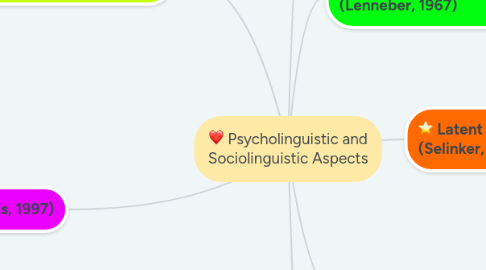Psycholinguistic and Sociolinguistic Aspects
by Maria Reyes


1. Stylistic Continuum (Tarone, 1979)
1.1. Versatility in different situations.
1.2. Studying language in its social context.
1.2.1. Vernacular Style
1.2.1.1. Less attention to speech
1.2.1.2. Spontaneous choices/linguistic forms
1.2.2. Careful Style
1.2.2.1. Formal setup
1.2.2.2. More attention to speech
1.2.2.3. Conscientious attention to linguistic forms
2. Acculturation Model (Ellis, 1997)
2.1. Social factors.
2.2. Could be two cultures not congruent.
2.2.1. L2 learners group consider itself subordinate.
2.2.2. TL group would consider L2 learners subordinated.
2.3. Two groups with negative attitudes.
2.4. Social distance.
3. Reestructuring (Corder, 1978)
3.1. New data influences aquired knowledge and vice versa.
3.2. Learners create unique rules (Not found on L1 or TL).
3.3. Gradually reestructuring.
3.4. Replaces L1 rules with L2 rules.
4. Latent Language structure (Lenneber, 1967)
4.1. Inherent/human mind.
4.2. Biological basic/Univ grammar.
4.3. Transformed/Maturational stages.
5. Latent Psychological Structure (Selinker, 1972)
5.1. No genetic timetable
5.2. There is no "Universal grammar"
5.3. Overlapping exists.
5.4. All L2 learners activate LPS.
6. The Built-in Syllabus (Corder, 1967)
6.1. Strong Version
6.1.1. Learners Follow same developmental path
6.1.2. Same processes in L1 & L2
6.1.3. Natural order of aquisition
6.1.4. Sequential organizer for receiving L2 data.
6.2. Weak Version
6.2.1. L2 aquisition determinated by some extent by the L1
6.2.2. Sequential organizer for receiving L2 data.
